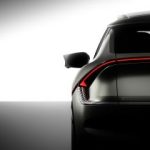
 Traditional looks and contemporary tech combine in updated six-cylinder roadster All is not as it seems at the Morgan Motor Company.This quintessentially English car maker is largely owned by an Italian firm and has an Italian CEO, its cars are powered by German engines and the ash wood for its frames comes from⦠a forest in Leicestershire.Well, some things arenât so different after all. But in order to continue providing the slice of ye olde English motoring that Morgan specialises in, it has had to evolve with the times. As a result, current Morgans are much more modern than they might appear.Although they didnât look it (which was entirely the point), the Morgan Plus Four and Plus Six were totally new when they were introduced in 2020, with a new bonded aluminium spaceframe and a pair of emissions-friendly BMW engines.While Morgan doesnât follow the same new-model-facelift churn as mainstream car brands, it has in the past four years identified a number of areas for improvement, including some that we remarked on in our early tests of the cars.We road tested the current Plus Four shortly after its launch (12 August 2020), but weâve never strapped the timing gear to the 335bhp Plus Six, so letâs do that now and see if the updates hit the spot.The range at a glanceModelsPowerFromPlus Four255bhp£71,830Plus Six335bhp£90,390The Morgan range is easy to understand, because there are just three models: the three-wheeled Super 3 and the Plus twins.The Plus Four has a 2.0-litre four-cylinder and the Plus Six a 3.0-litre six, both from BMW. The Plus Four can be had with either a manual or automatic gearbox, but the Plus Six is automatic-only. Although the two share a bonded aluminium chassis, the Plus Six has a wider body.
Traditional looks and contemporary tech combine in updated six-cylinder roadster All is not as it seems at the Morgan Motor Company.This quintessentially English car maker is largely owned by an Italian firm and has an Italian CEO, its cars are powered by German engines and the ash wood for its frames comes from⦠a forest in Leicestershire.Well, some things arenât so different after all. But in order to continue providing the slice of ye olde English motoring that Morgan specialises in, it has had to evolve with the times. As a result, current Morgans are much more modern than they might appear.Although they didnât look it (which was entirely the point), the Morgan Plus Four and Plus Six were totally new when they were introduced in 2020, with a new bonded aluminium spaceframe and a pair of emissions-friendly BMW engines.While Morgan doesnât follow the same new-model-facelift churn as mainstream car brands, it has in the past four years identified a number of areas for improvement, including some that we remarked on in our early tests of the cars.We road tested the current Plus Four shortly after its launch (12 August 2020), but weâve never strapped the timing gear to the 335bhp Plus Six, so letâs do that now and see if the updates hit the spot.The range at a glanceModelsPowerFromPlus Four255bhp£71,830Plus Six335bhp£90,390The Morgan range is easy to understand, because there are just three models: the three-wheeled Super 3 and the Plus twins.The Plus Four has a 2.0-litre four-cylinder and the Plus Six a 3.0-litre six, both from BMW. The Plus Four can be had with either a manual or automatic gearbox, but the Plus Six is automatic-only. Although the two share a bonded aluminium chassis, the Plus Six has a wider body. Picture Britain’s typical family-owned and operated business. The sort that mothers and fathers pass on to their kids, or in which uncles, aunties and cousins all pitch in together. You’re imagining a chip shop, right? Just me? Perhaps a pub, a corner shop or a post office, then. Not a car factory, I’d bet.
Well, just imagine one – if you can. It won’t be easy. Making cars isn’t something you succeed at simply by getting up early, drinking lots of tea, getting your hands dirty and having a go. It’s complicated. It requires up-to-date specialist know-how, and expert design, engineering and manufacturing skill. Peeling spuds, pulling pints or stamping envelopes, it ain’t. And yet The Morgan Motor Company was family-owned and operated right until the year of its 110th anniversary; this year. Not a bad innings, that.
Change has finally come to Pickersleigh Road, however. Earlier this year, the Morgan family decided to sell a majority share of the business to the Investindustrial private equity group that previously owned Aston Martin until its recent market flotation.
Ask around at the firm’s visitors’ centre as to why that decision was taken, and the answers come very honestly. “It was the right offer, when all the others over the years just weren’t,” one staffer said. “We’d reached the point where the family was beginning to hold the company back rather than drive it on. Growing the business now needs investment and well-connected, industry-savvy leadership. Which, we’re hoping, is what we’ve now got.”
At the same time as announcing that change in ownership, back in March, Morgan also announced its first ground-up new car in 19 years: this one, the Plus Six. In development since 2016, this’d be better thought of as the old regime’s parting gift to the company rather than the first fruit of the new one. Ironically, though, it’s definitely ‘all-new’ enough to feel like the latter.
How does the Plus Six stand out from other Morgan models?
Based on a new aluminium box-section monocoque chassis twice as stiff as the old Aero-series chassis that served under the Plus Eight, but also no more heavy, it’s also the first factory Morgan with a turbocharged engine: BMW’s 335bhp ‘B58’ turbo straight six hooked up to the familiar ZF eight-speed automatic gearbox. Unlike any Morgan before it, the Plus Six has electromechanical power steering, and its new chassis has even been designed to accommodate electric drive motors in future.
You’re getting into a little bit of the company’s future, then, when you click the chromed button door release, swing open the tiny, cut-down driver’s door, and step over one of those famously wide running boards to lower yourself carefully into the Plus Six’s all-new cockpit. The seats remain pretty narrow, just like the footwells – but the cabin has clearly grown for length, with this 6ft 3in tester is genuinely spoilt for leg room. There’s both reach and rake adjustment on the steering column, and a very sound layout of controls overall. I’m not sure that footwell leaves room for a third pedal except at a squeeze, though there has been talk of a manual version. Even so, chances are you could be comfy here for a few hours at a stretch, almost regardless of how you’re built.
The Plus Six’s cabin finish is generally very good. Our test car had attractive ‘box weave’ carpets, embroidered headrests and soft, attentively stitched hides – though it could have done with a more appealing-looking steering wheel. Instrumentation is by traditional analogue clocks placed, in Morgan convention, in the middle of the fascia – and the more distant positioning of the speedo than the rev counter, together with the size of its numbering, makes you glad there’s also a small digital trip computer screen with a digital speedo visible through the orbit of the steering wheel rim. If not for that, you’d need to take a passenger with you at all times, just to tap you on the knee as you hit the national speed limit – which, for all I know, may very well be what Morgan owners do anyway, just in case.
How does the Morgan Plus Six perform on the road?
And it really wouldn’t take long to hit that limit, by the way. That BMW straight six sounds a bit tuneless at times, offering a lot more turbo induction noise than exhaust burble under load – although an ‘aftermarket’ exhaust which might, I suspect, be fitted to your car even before it leaves the factory, apparently adds greater audible fruitiness.
Assuming it adds enough of it, there’d be very little else to find wanting here about a powertrain with more torque than a top-of-the-range six-pot Jaguar F-Type operating in a car weighing half-a-tonne less. The Plus Six is instantly quick, picking up from dawdling speeds with real swiftness. It is not a car that needs to be driven at all hard to go fast, or to feel enlivening for its outright pace. That’s new ground for Morgan, in my experience. There’s no doubt that a good manual version would be more involving and, to this tester, would suit the car better. Still, the ZF auto’s manual mode is quick enough to feel like a very acceptable compromise, and it’s as slick as anywhere when shifting by itself (although I do wish Morgan had found some nicer-feeling shift paddles than the somewhat flimsy, plasticky ones familiar from the PSA-Peugeot–Citroen parts bin).
On to that new chassis, then, which pretty plainly gives Morgan a great deal of fresh opportunity for enhancing and fine-tuning the handling of this car – but which you wouldn’t say it had fully explored just yet. It has certainly helped to banish some of the worst dynamic traits that Morgan owners may be used to from this car. The Plus Six tracks very straight over bumps taken at speed. It has a reasonable amount of supple compliance in a ride that remains only medium-firm feeling; one that doesn’t feel nearly as wooden or brittle as some Morgans have, over the years, but that still struggles to keep perfect close control over pitch and squat.
The new chassis has put a little bit of extra length into the car’s wheelbase compared with that of its predecessor model, and yet it retains steering that’s uncharacteristically slow by sports car standards, with almost three full turns between not especially tight-feeling extremes of lock. It’s also suddenly quite light of weighting.
For both reasons, while the Plus Six handles gentler faster bends with appealing precision, it doesn’t feel quite as agile, wieldy or keen as it might through tighter ones – and for what remains a small, light sports car, you really do notice. It was a contributing factor, for this tester at least, in eroding slightly the immediacy of control you’d ideally like over the car’s steered axle – the other being the sheer distance between that axle and where you sit in the car, which is another way in which this appealingly small two-seater is made to feel larger than it might.
How does the Plus Six compare to more mainstream sports cars?
You’d certainly have to get used to the proportions of the Plus Six were you to buy one – likewise the slightly athletic entry and exit routine, the placing of the minor switchgear, and the intricate sequence of doing and undoing of steel pop fasteners and opening and closing of latches necessary to get the roof up quickly in a shower. So much of all of that feels akin to memorising the password for the manned door of the owner’s club. It’d all be a labour of love to get to know, I’m sure – and, for the lovers, the dynamic strides that Morgan has taken with this car will surely seem great.
For me, it’s what this chassis might go on to do that’s really interesting – because while the Plus Six is a lot better than you expect it might be in some ways, and in others quite honestly just a lot less bad than you might have feared, it now seems tantalisingly close to becoming a much better driver’s car with the right kind of dynamic tuning. I’m not suggesting it’ll ever handle like a Porsche, Lotus or Alpine – and neither would anyone want it to. But it’s certainly diverting to wonder, for now, just how close it might get.

Morgan Plus Six
TECHNICAL SPECS

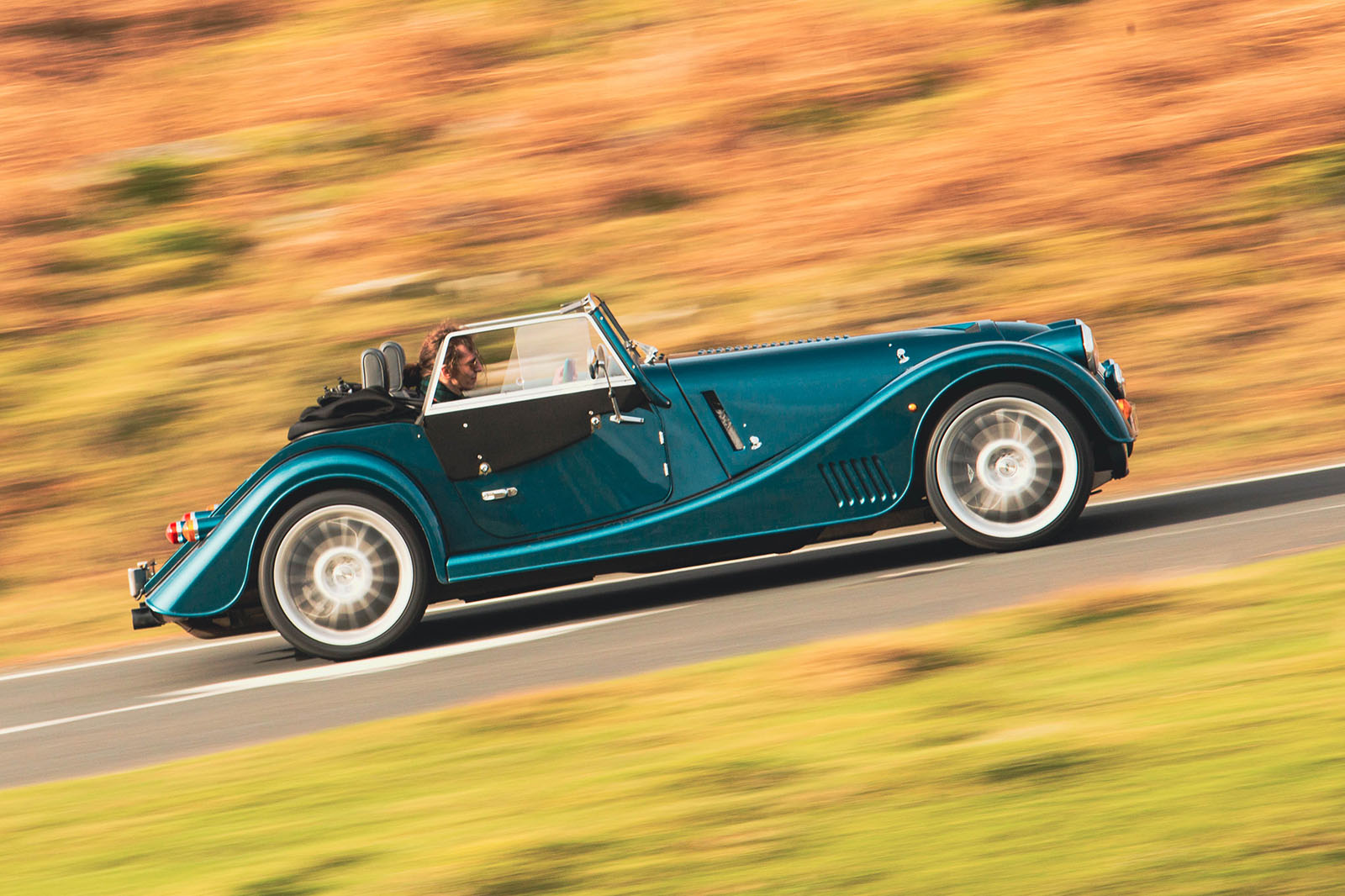
Morgan calls its bonded and riveted aluminium spaceframe the CX platform, referring to the company’s 110th anniversary year in Roman numerals.
And before you ask: no, the aluminium doesn’t come from a tree. Morgan does still employ ash wood to hold the aluminium body panels, because it says that wood is the best material to support the car’s distinctive curves. All the strength comes from the chassis, however.
The four-cylinder Plus Four and six-cylinder Plus Six look the same at a glance, but the Six is wider overall, with most of that width in the middle of the car, rather than just a wider track. That way it benefits interior space. You can also identify the Six by its larger wheels.
Power still comes from the familiar BMW 2.0-litre B48 inline four in the Plus Four and 3.0-litre B58 inline six in the Plus Six – the same as you might find in a BMW 2 Series Coupe (specifically the 230i and M240i), albeit slightly detuned in the case of the Morgan.
Over the past few years, the Plus cars have had two fairly extensive rounds of upgrades. The first, in 2021, included a redesign of the hood to make it less fiddly, the option of upgraded Comfort Plus seats and a sports exhaust and the addition of some USB ports. More profound changes arrived in 2023, including an interior redesign and a host of chassis tweaks.
Suspension is by double wishbones front and rear, as before. However, the dampers and bushes have been changed for more compliant items. The front brakes have also been upgraded. Now by AP Racing, the discs have grown from 315mm to 332mm.
The more significant news is that Morgan has worked with Continental to develop a traction and stability control system, in addition to the ABS that the CX-generation cars had from launch. Morgan has been on a safety drive with the latest Plus cars, as it has also redesigned the dashboard to accommodate a pair of airbags.
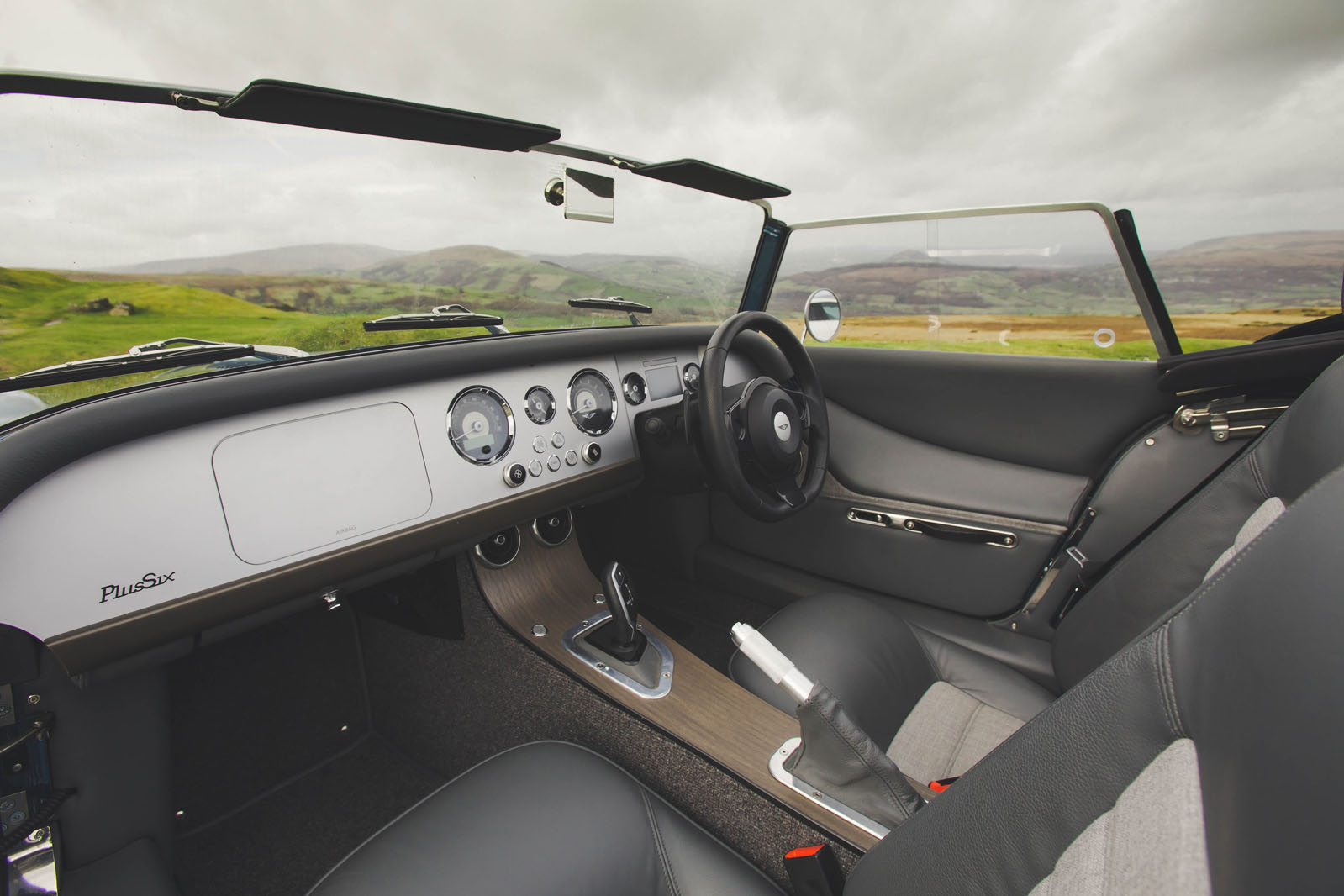
The biggest interior change compared with earlier Plus Sixes comes from the fitting of those airbags. That has required a redesign of the dashboard, although it’s sympathetic enough that you probably wouldn’t notice if you’re not intimately familiar with the pre-update style. The steering wheel always looked like it had an airbag in it anyway.
The main dashboard panel, available in black, silver or body-colour aluminium, is now flat, with the space formerly taken up by a cubby now filled by the passenger airbag. There is at least a small glovebox to compensate.
The centre of the dashboard is still taken up by the analogue clock, tacho and speedo. The latter is mostly ornamental in practice, as you tend to glance at the subtly enlarged digital display in front of you, but then a Morgan is the kind of car that’s complemented by a bit of ornamentation.
The push buttons for the secondary controls work well enough, as do the rotary knobs for the heating and ventilation. That said, it’s odd that there are no telltales of how high or low you’ve set the fan and heating; you need to look at the driver’s display for that.
It’s unfortunate that Morgan hasn’t taken the opportunity to find an alternative for the PSA-sourced shift paddles and column stalks. We like the column-mounted paddles in Ferraris and Alfa Romeos, because they’re big and satisfying to use, but the flimsy plastic ears in the Morgan can be hard to find when you have some steering lock on. Equally, the stalks feel out of step with the obvious craftsmanship in the rest of the interior.
And rest assured, there is plenty of that. You can choose from a range of veneers for the centre console and the rail under the dashboard, the leather feels wonderfully soft and in this updated model there’s more scope to mix things up with some interesting fabrics, which now line redesigned door cards.
Overall, this is a superbly designed interior, one that is the antithesis of the modern trend of hitting you over the head with technology. Instead, this does have the essentials (air-con, heated seats and a Bluetooth speaker system are optional) but hides them from view.
It also provides you with a classic sports car driving position: low, with your legs outstretched and the steering wheel (adjustable for rake and reach) close to your chest. Unusually, it favours taller drivers, who have an abundance of leg room. Shorter testers complained that the steering wheel was slightly too close for comfort.
The seats are manually adjustable, and the lever for the backrest has been repositioned to be easier to reach. On the Comfort Plus seats in our test car, there were two hand pumps for the lumbar and thigh support. They proved quite comfortable but caused some slight upper backache on very long drives.
For those long drives, you will need to pack carefully, because there is no boot as such. The shelf behind the seats forms the main storage area and will hold a pair of soft bags. For anything more, you will either need to kick out your passenger or go for the optional luggage rack.

Multimedia system
An infotainment system? In a Morgan? Well, sort of. There are no touchscreens to be found here, but one of the headline changes for 2023 was the option of a Sennheiser audio system. You don’t get any speakers as standard, the basic Bluetooth speaker system is £395 and the Sennheiser system costs £2995.
Sound comes from four conventional speakers in the doors and the rear storage area, and four invisible speakers, of which three are behind the dashboard and one in the lower compartment panel for the bass.
The trouble is that no matter how good the audio system might be, it’s always fighting a losing battle with wind noise in a Plus Six. At low speeds, it’s genuinely pleasurable, but on the motorway you have to strain to understand a podcast.
The Bluetooth connection proved simple and reliable, and although we found the hidden volume under the dashboard slightly odd, it does the job.
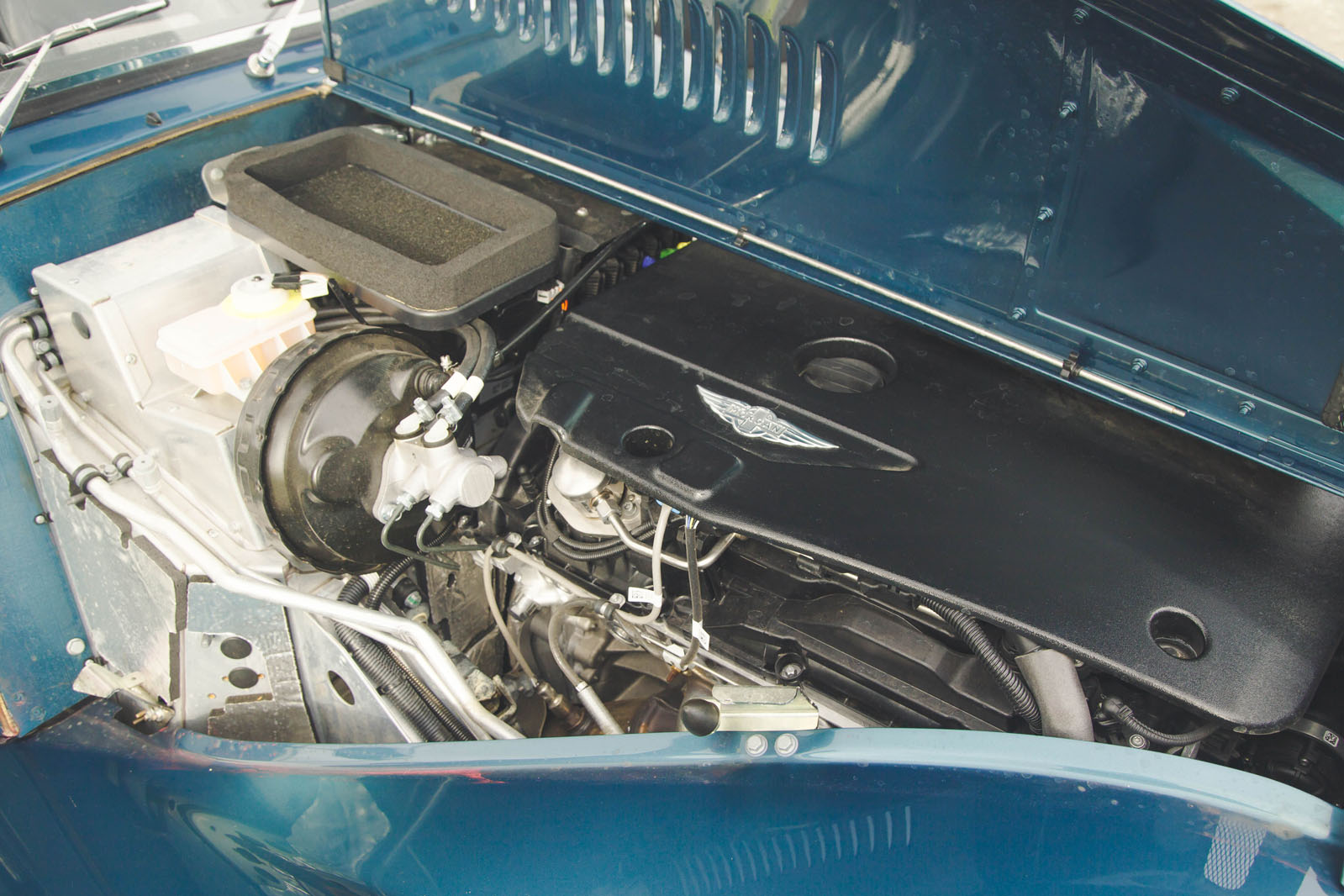
The Plus Six’s performance figures are a lesson in the power of lightness and aerodynamics.
It has the same engine and eight-speed automatic gearbox as the Toyota GR Supra that we tested in 2019. While the Toyota weighed 1495kg on our scales, the Morgan weighs just 1188kg.
Launching the Plus Six cleanly in the wet takes a little practice, because once the engine hits its powerband, it’s easy to convert the power to wheelspin in first through third gear. Things are easier after that, as the engine doesn’t care very much when you shift up, being all about the mid-range.
The Supra got away more cleanly in the dry, but the Plus Six quickly catches up, and the two recorded identical 0-60mph times of 4.4sec. In better conditions, the Morgan would likely dip under 4.0sec. To 100mph, the Plus Six takes nearly 1.5sec out of the Supra, but to 130mph the gap starts to close again as the Morgan runs into an aerodynamic wall.
Exceeding 100mph in a Plus Six is also a little more adventurous than in most performance cars. It feels perfectly stable and planted, but the handbook also recommends not to drive at “excessive speeds with the hood and sidescreens up”. An open-air 140mph is quite the experience, particularly since any light drizzle is sucked onto the inside of the windscreen; make sure to have a rag at the ready.
Back on the road, it’s a wonderful powertrain that, liberated of the kilos of the cars it normally powers, punches all the harder. The way the sports exhaust adds a bit of raspiness to the almost overly refined base character of the engine, without making it too shouty, makes it a must-have. It can occasionally sound a little like a V6 in the mid-range, but that’s not the worst thing in the world.
Morgan has tweaked the software for the gearbox so that it’s keener to downshift in automatic mode and to give it a sportier calibration in the sport modes. In the standard D mode, it seems to try to emulate a Porsche PDK, rifling through the lower gears somewhat forcefully but not clumsily, signalling some sporting intent. In the sport modes, it’s more alert and will downshift while braking, but it doesn’t hold onto gears unnecessarily. It’s better resolved than in many mainstream cars. Responses are good in manual mode, too.
hen they first go for the brake pedal, some drivers may be slightly put off by how much pressure it requires, as the brakes feel almost unassisted. However, those more familiar with other lightweight sports cars will feel at home and appreciate how easy to modulate the Morgan’s brakes are. The ABS functioned impeccably well too, stopping the car from high speed with no drama whatsoever.
PERFORMANCE

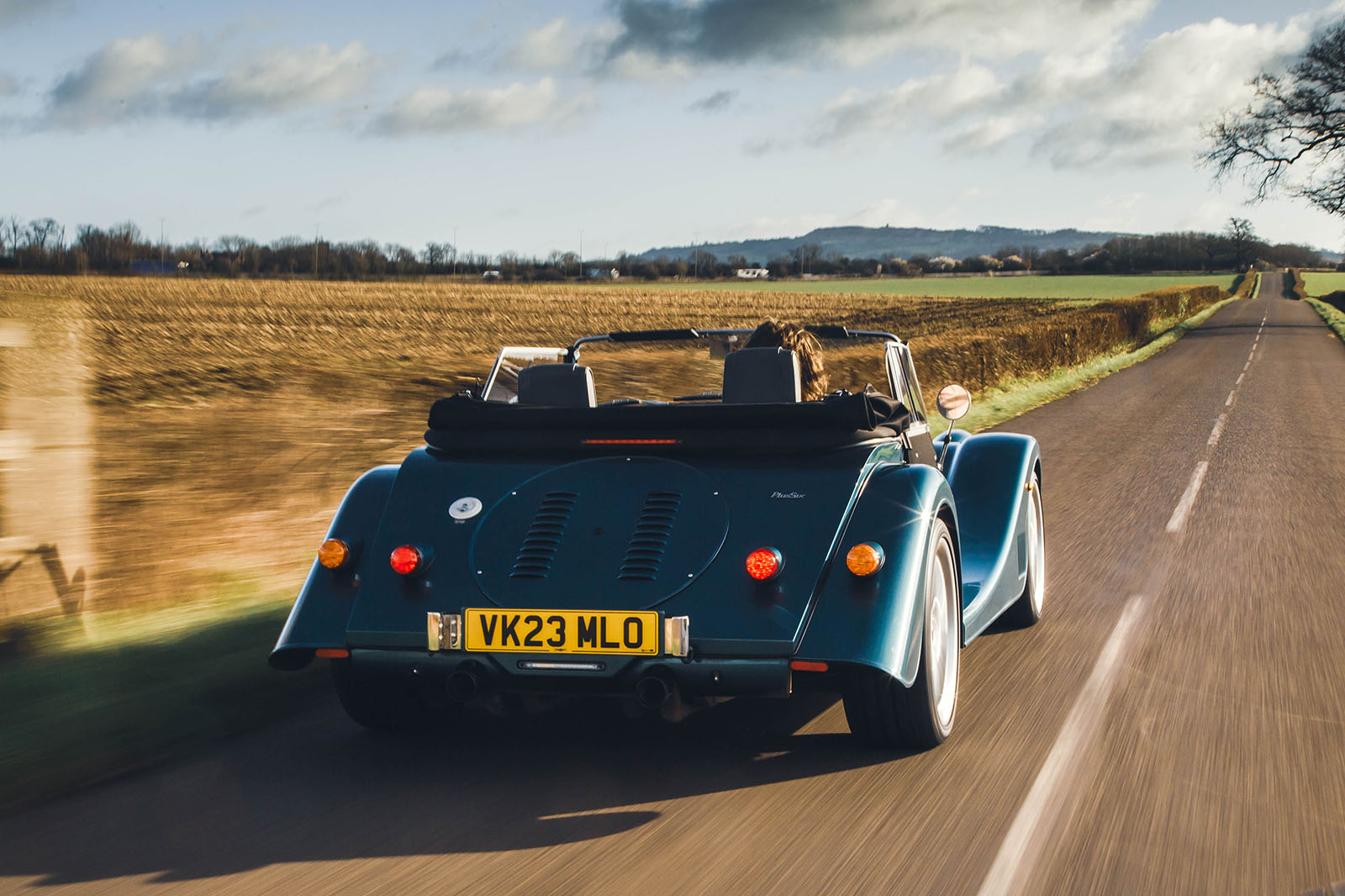
If the Plus Six looks a bit like a luxury Caterham, that’s not entirely how it drives. It inevitably shares some traits with the lightweight hero, chiefly the sensation of sitting deep in the chassis and on the back axle, while the steered wheels feel as if they are in the next county.
However, the electric power steering, less rigid chassis and not-quite-featherlight kerb weight mean the Plus Six can’t manage the same levels of precision and feedback, putting it midway between a classic and a more modern roadster. And that’s not a bad place for the Morgan to live.
By modern standards, the medium-weighted steering is rather slow for a sports car, and it’s not bursting with feedback. There’s just enough, however, and the response is linear, which hasn’t always been the case with Morgans. It takes a bit of getting used to, but once you do, it gives you enough confidence to push on. Testers who had also driven the Plus Four did report that the lighter front end made it sweeter to steer, with more natural build-up of weight and less delayed responses.
The Plus Six isn’t especially firmly sprung, so it takes bumpy roads in its stride despite not being over-endowed with suspension travel. Large wheels and some chassis flex conspire to make the ride moderately brittle – certainly more so than on the Plus Four.
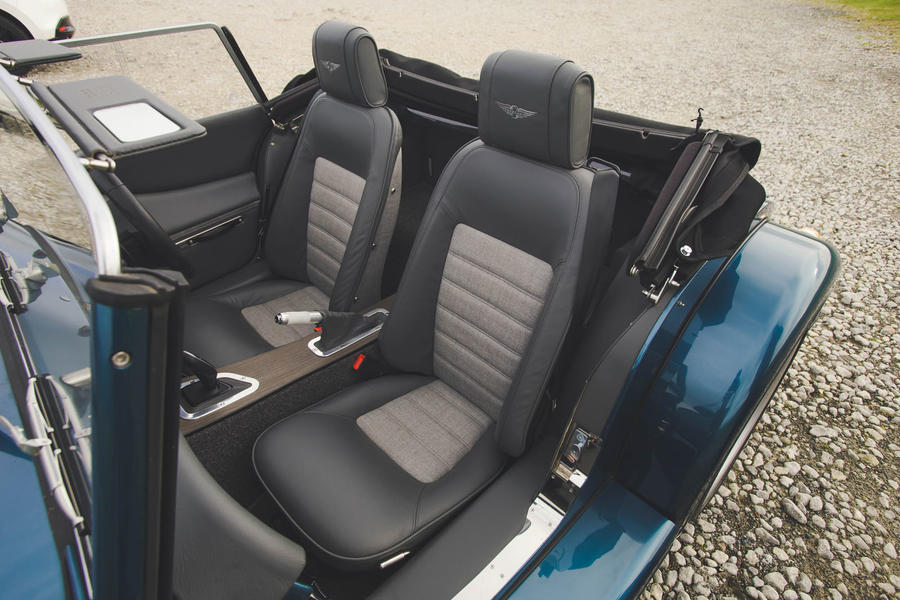
Comfort & Isolation
Two and a half stars will seem unfair to the Morgan faithful, who would argue that what we’re about to say describes intrinsic aspects of the British roadster experience. But quite simply, someone used to their BMW Z4 or Porsche 718 Boxster may be in for a shock with a Plus Six.
The hood, while much easier to erect and stow than previous iterations, is still quite fiddly, with its catches that don’t line up perfectly every time, and the way it wants to be folded a particular way. It heightens one’s appreciation for the simple and ultra-user-friendly hood in Mazda’s MX-5. It’s also quite a thin piece of fabric that lets in plenty of road and wind roar, hence why our noise reading at 70mph was lower with the car’s top down (it was admittedly quite a windy day).
The sidescreens are removable, but even with them in place, the Morgan’s cabin is draughty and not entirely watertight when driven in heavy rain. The air-con does a good job at stopping the windows from misting up and the heater is reasonably strong. However, the Plus Six only has two vents in the centre console, so it’s possible for your left arm to be roasting, your right arm freezing in the draught.
With all that said, the high-speed ride and the seats are mostly comfortable, and at least there’s a roof, a heater and an (optional) sound system, so long-distance touring and even daily usage don’t require great commitment, unlike with an Ariel Atom or a Caterham.

A Morgan is a low-volume, specialist, hand-built car: the firm made only around 700 cars in 2023, with about 30% of those Plus Sixes.
So it shouldn’t be a surprise that a Plus Six is more expensive than more mainstream alternatives. Prices start at £90,390, but it’s safe to assume that an option-free Plus Six doesn’t exist. Our test car, which seems fairly typically specified, was £109,960.
A BMW Z4 with the same engine needn’t cost more than £60,000. Then again, you don’t need to go too crazy with the options to turn a 718 Boxster GTS 4.0 into a £90,000 proposition. Morgans also hold their value exceptionally well. CAP doesn’t have any data, but a look at the classifieds suggests a four-year-old one is still worth £70,000.
ven so, finance remains fairly expensive. For a car similar to our test car, Morgan requires quite a large deposit, and there’s a big balloon payment at the end as well.
Fuel economy is excellent, given the performance potential. Before doing the performance testing, we calculated 36.7mpg. The small, 43-litre fuel tank still limits cruising range, however.The Plus Six’s niche nature means you might have to put up with the odd foible. However, thanks to plenty of proven components, it shouldn’t be too troublesome, and in general our test car gave off a feeling of solidity that inspired the confidence to drive it in all conditions.
The standard warranty runs for 30 months/30,000 miles and can be extended to 48 months/48,000 miles. This costs an extra £1445 and is also included in finance packages.
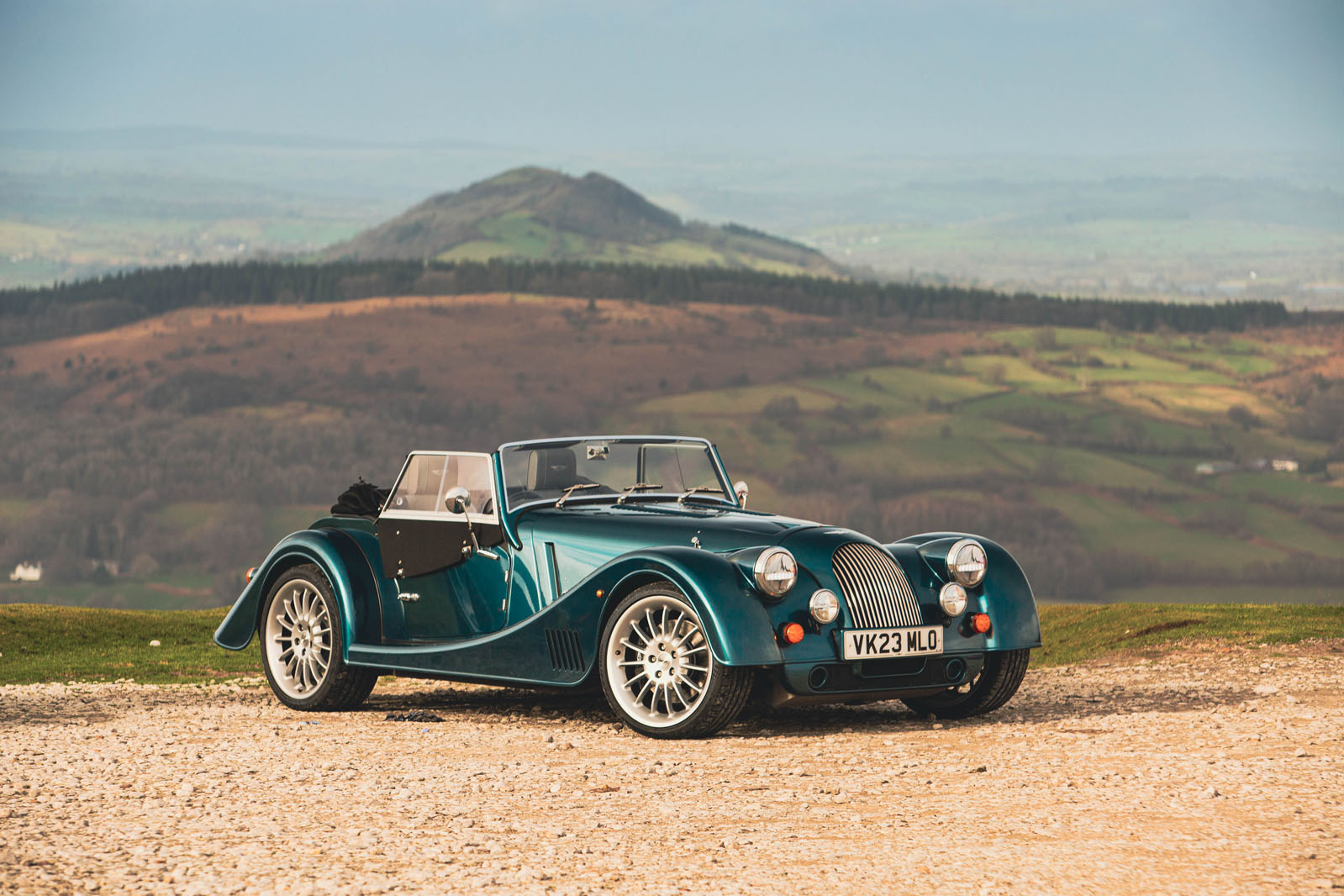

Morgan Plus Six
By using mainstream powertrains in a very effective way, cleverly updating its cars and playing nicely within the rules for small-volume manufacturers, Morgan seems to be thriving.
Of course, those same rules limit how many cars it can sell, and the Plus Six is hardly affordable. Then again, neither is it so exclusive as to be destined to remain a billionaire’s garage ornament.
The BMW Z4 and Porsche 718 Boxster are objectively better cars, there’s no doubt. More affordable, too. But Morgan won’t feel too threatened by that fact. A Plus Six is capable enough to be easy to own and stand up to scrutiny as a modern sports car, yet it has the character and style to appeal to the individualist for whom the aforementioned alternatives are just too ordinary.
If the Plus Six has a problem, it’s that the cheaper, lighter Plus Four is sweeter to drive and its four-cylinder engine’s rortier character somehow fits the car’s vibe better. Be that as it may, it’s a good problem for Morgan to have, and we wouldn’t blame you if you can’t resist the additional musicality, power and clout of the Six.




